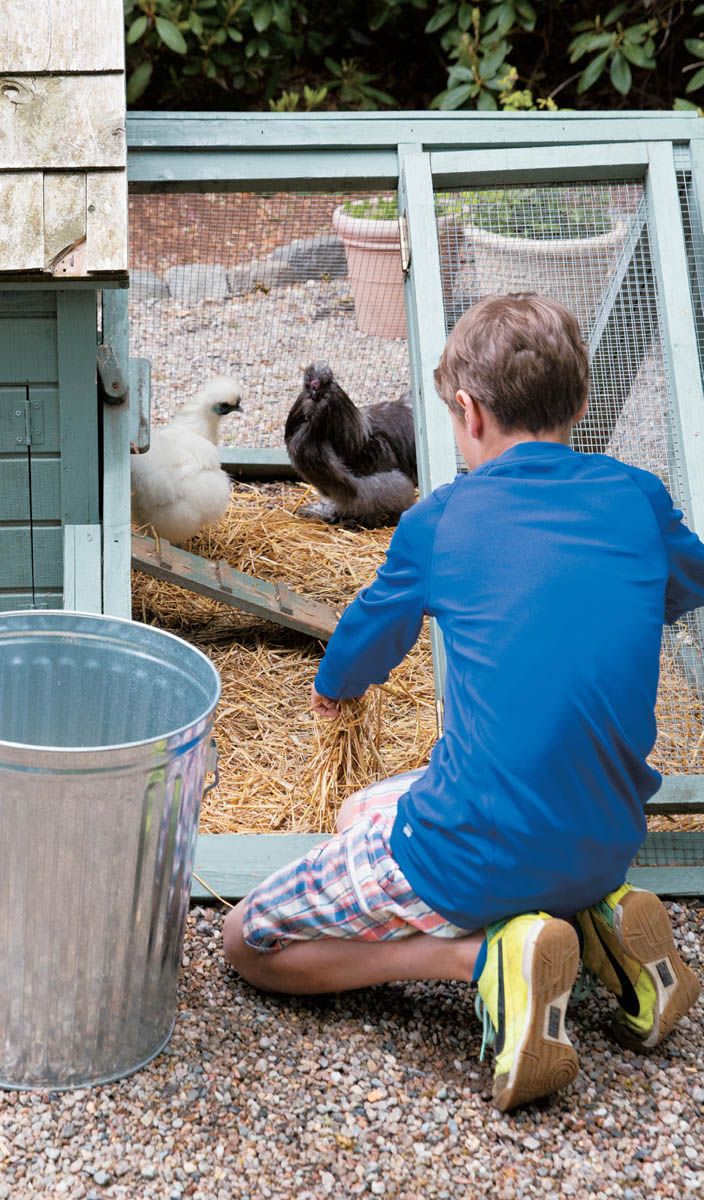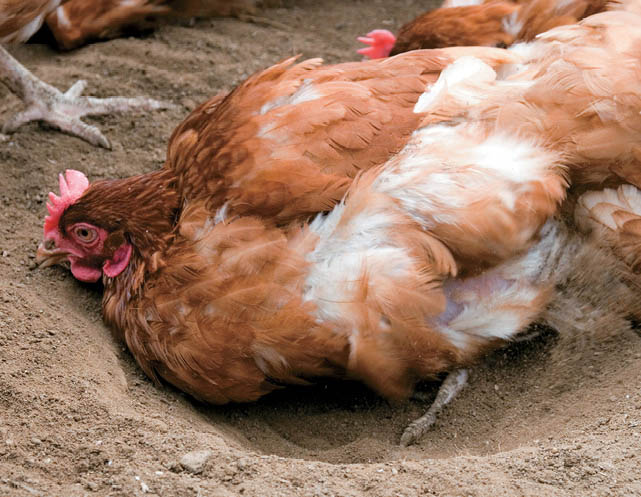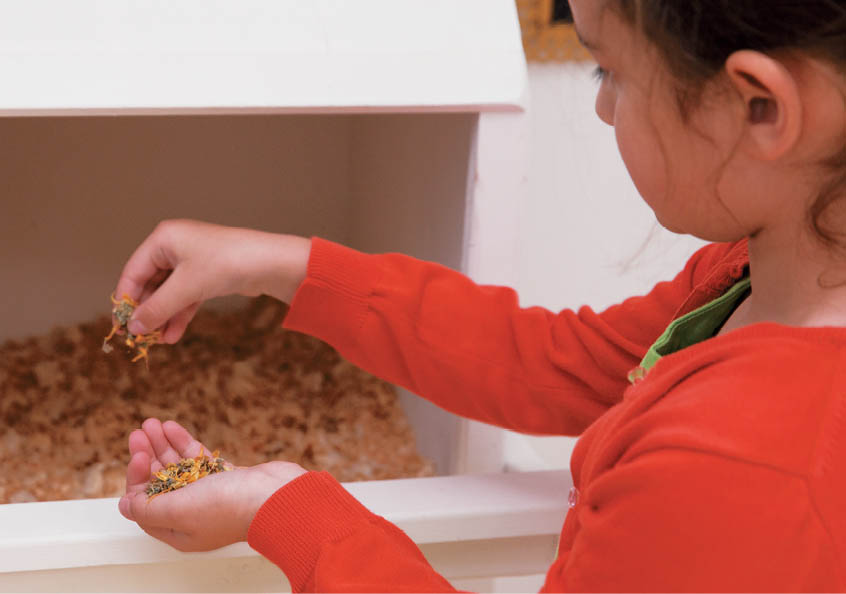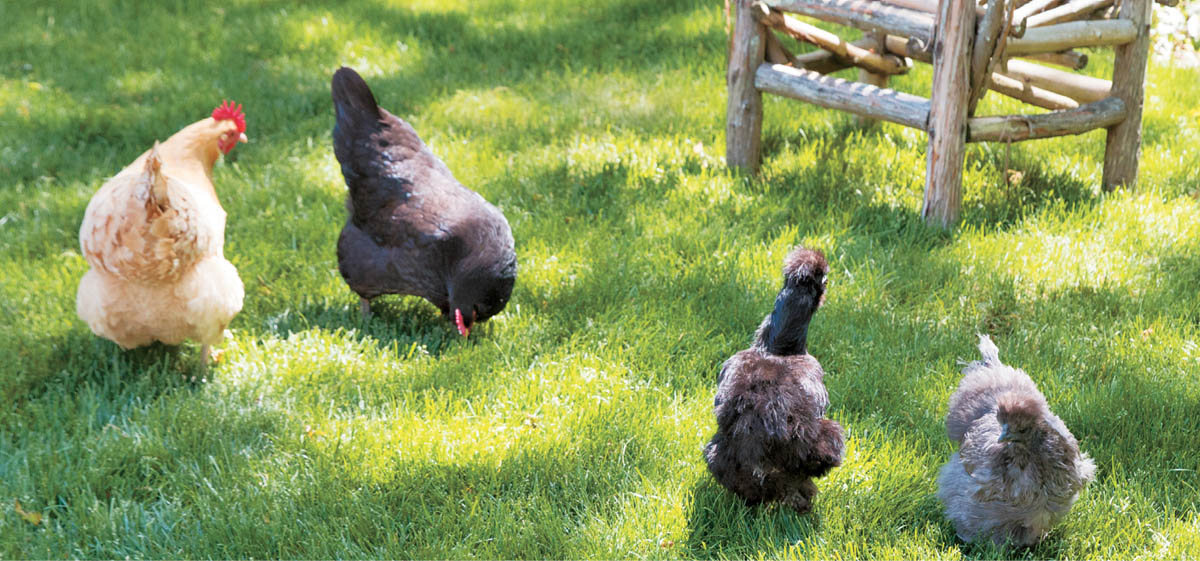
I’m pretty sure your parents won’t let you keep a grown chicken in your bedroom (although you can buy diapers for indoor chickens, believe it or not). For one thing, chickens can be pretty messy, even messier than kids!
For another, chickens are actually happier living outside, as long as you provide them with a clean, safe coop with enough room for each hen to stretch her wings. The coop is the chickens’ house, where they sleep and lay their eggs and hang out in bad weather.
The run is their yard — it’s an enclosed outside space where they can exercise and scratch around for bugs. They can move between the two during the day, but they should be locked into the coop at night.

In chapter 1, we talked about how much space you need to keep a small flock, and now we’ll look at what kind of housing and fencing you need to build. You’ll find as many styles of chicken coops as there are kinds of people houses, but the good ones all have the same characteristics: they are safe, dry, and comfortable.
In the wintertime, we like to make seed rolls for the wild birds and the chickens. This fun treat encourages chickens to peck at something else besides one another.

When selecting the best place for your chicken coop, first review your local laws. In addition to observing those requirements, be considerate of your neighbors. Be sure to follow the guidelines for setbacks and the proper distances from other buildings and property boundaries.
The spot should be level and flat, with good drainage — not a place where water collects in puddles. It should receive some sun during the day to help keep things dry but should have some shade as well. It should be visible from your home, so you can check on your flock from a window. Don’t forget to consider ease of access, which is especially important if you live in a place where it snows.

This small coop with a moveable run is situated at the edge of a driveway near some trees, where it is sheltered from bad weather but can easily be seen from the house.
Some coop and run setups are permanent, while others have wheels and can be moved to new locations. The movable models are called chicken tractors (some have wheels), and they can be constructed to hold flocks of all sizes.The most important thing about the coop is that it be weatherproof. In addition to being in a dry location, it should be sturdy enough to stand up to strong gusts of wind. Every coop needs doors with predator-proof latches, a vital feature for the safety of your flock.
Base the design of your coop on the climate where you live. If you live in a cold place, you might consider insulating the coop. If you live in a place with considerable rainfall, a sloped roof is a must. If space is limited, the run can be built partially or entirely underneath the coop. If you love gardening, you can create a living roof made of plants. Coops can have skylights, windows, and other customized features. You can have an open-top run or a covered one that provides shelter for the flock.
You can buy books about building coops, or check them out at your local library, or look online for free plans. You can also order chicken coops that are ready to assemble, or that come preassembled. These can be a bit pricier due to shipping costs. They are heavy. Building a coop takes time and planning, but it keeps the cost down compared to purchasing a preconstructed coop.
People have also converted old doghouses, playhouses, gardening sheds, and so forth into coops. Your only limitation is your budget and your imagination!




When creating your coop and run, allow approximately 10 square feet of total space per standard chicken and 5 to 7 feet per bantam. Typically, chicken coops have a floor with four walls and a roof. Some look like garden sheds or mini houses.
The coop should be draft-free while having good ventilation. Ventilation is usually provided by a window or vent near the top of the coop. A window that opens and closes is a good idea. The window offers light to stimulate egg production and provides ventilation on warm summer days. The coop and run should have places for a feeder and a waterer, as well as small hanging dishes for oyster shells and grit.

We designed our second coop with plenty of windows to provide ventilation and light. Hardware cloth screens keep out predators.
Each chicken should have about two feet of roosting space above the ground. The roosts should be smooth, rounded, and no more than two inches wide. Removable roosts are the easiest to clean. After you clean them, you can place them in a sunny spot to dry.
Lining the nesting boxes and the coop floor with linoleum makes cleaning the coop a great deal easier. It is washable and also extends the lifetime of the coop. Check flooring stores for affordable linoleum remnants (pieces left over after bigger pieces have been cut).

We love that our chickens keep us grounded. Some people may believe that you need material things to be happy, but the happiness those things brings quickly fades. In reality, what is important is right in front of you. The chickens remind us that simple is better.
Chickens don’t need cell phones, laptops, fancy shoes, or expensive toys. They enjoy an occasional treat, but all they really need is proper shelter and enough food and water. They don’t spend all their time texting, watching TV, or playing video games. They like being outdoors, free to explore. They wake up together every morning, eat together, and roost together.
A home is made with those who care about you. It should be a sanctuary where you are supported, loved, and believed in. It can even be in your heart. Our chickens remind us of the way a home should be.
Here’s one way to set up a coop — there are plenty of different ways to include these key features.

Nesting boxes are safe places where hens lay their eggs. Designs vary, but any box should be approximately 12 inches by 12 inches and filled with nesting material such as pine shavings. Some nesting boxes hang outside the coop and are accessible though a trapdoor that allows you to reach in to collect the eggs.
Whatever the design, nesting boxes should be elevated slightly off the ground. Most people put the nesting boxes in a dark corner, where the hens feel more protected. Some people even craft curtains to provide privacy.

Multiple nesting boxes give your hens a choice of places to lay eggs — they often pick a favorite spot.
There should be one nesting box per three or four hens. You will probably discover that all the hens like the same nesting box. Our hens have several choices, but we often find them lined up waiting to lay their eggs in one particular nest!
Some chickens develop the bad habit of sleeping — and pooping — in the nesting boxes overnight. This leaves you with dirty chickens and dirty eggs. If you find a chicken prefers spending the night in a nesting box, simply wait until nightfall to scoop her up and gently guide her feet onto the roost. Chickens can’t see in the dark, so she’ll be easier to handle and won’t leave the roost for the night. It might take a few days to retrain her.
Hens shouldn’t have nesting boxes until they are at least 18 weeks old. Simply block the boxes off with cardboard until the chicks are all habitually sleeping on the roosts and are closer to egg-laying age.
Electricity in the coop can be a bonus, although you must encase the wires, because chickens will peck them out of curiosity. Electricity allows you to add lights, fans, and devices to keep waterers from freezing.
Having a light in the winter provides hens with more “daylight,” which stimulates their brains to keep laying eggs. This, of course, is optional. We do not light the coop and our hens still lay during the winter, although the number of eggs certainly tapers off.
If you do add a light, put it on a timer, so it turns on early in the morning and turns off when there is still daylight. This way, no chicken is injured if the light suddenly turns off in the evening’s darkness when the flock has not yet settled onto their roosts for sleep.
You know that phrase “all cooped up”? Well, you don’t want your flock to feel that way, so your coop needs an enclosed area where your chickens can safely roam during the day. Even if you allow your flock access to your yard, it’s a good idea to have a run. There will be times when you will not want them to roam because of predators or bad weather, or when you are on vacation and can’t keep an eye on them. Runs are often attached to the coop, but you can build a movable one so that your chickens have access to fresh grass.

Your chickens will appreciate having a place to perch in the run.
Be aware that chickens will scratch up a patch of ground pretty thoroughly, so a permanent run will soon become all dirt inside. Chickens also like to take dust baths to remove bugs and excess oil from their feathers. Some people provide their flock with a large shallow bin full of dirt, wood ash, and sand for a bathing station.
Build your run large enough, with the entire flock size in mind. Most chicken coops, even ones built low to the ground, have ramps leading from the coop into the run rather than a step — it’s just a little safer. The run should be sturdy, with a sloped roof if you choose to cover it. Most runs are constructed from lumber and hardware cloth. Some incorporate corrugated plastic sheets or even cedar shakes as roofing.

Rub-a-dub-dust! To take dust baths, chickens dig shallow holes and lie in them. They wiggle into the ground and use their wings to toss dirt and debris onto their bodies. Sometimes they appear to be doing yoga. Other times, they just relax and appear to have become completely boneless!

Some friends of ours made a fantastic jungle gym for their flock in their run. It looks like a barren tree and is about 8 feet tall and 5 feet wide.
The chickens hop from branch to branch and take naps perched up high. It’s a great place to hang treats, and you could even create a chicken swing with a small branch!

When building your coop and run, it’s very important to consider the predators in your area. Not all areas of the country have the same predators, but every area does has animals that would like to eat your chickens or their eggs.
Common threats include snakes, raptors, minks, weasels, raccoons, foxes, coyotes, and fisher cats, and even bobcats or bears. Contact your county’s cooperative extension office or your local fish and wildlife department to find out which predators you should watch out for.
Dogs and cats, both domestic and feral (wild), can also be a threat. In fact, pets can be a bigger problem for neighborhood chickens than other predators are, so use common sense when your flock is free-ranging.
Predators operate both day and night, and they are smart. They look for the easiest ways to access the chickens. They can dig into the run, break into the coop, or enter the run from overhead. Rats, weasels, and snakes can squeeze through tiny holes. Raccoons can even figure out how to open simple latches!
This may sound funny, but never use chicken wire to build your coop or run. Chicken wire is designed to keep chickens in, not to keep predators out. Use 1⁄2-inch hardware cloth instead; it is stronger. Bury hardware cloth at least 12 to 18 inches deep all around the perimeter of the coop and run, or make a 3-foot-wide hardware cloth apron (a part that extends out) around the run.

Keeping the coop clean and dry contributes to a healthy flock. Some people clean weekly, while others use a deep litter method. The deep litter method continually adds new bedding to the existing dirty bedding, which cuts down on frequent coop cleaning. You still have to clean the entire coop a few times per year and start over again. In the winter, this method helps generate heat in the coop.

It’s important to remove soiled shavings regularly, especially in a small coop like this one.
We prefer to clean our small coop more frequently. Each week we scoop out the soiled pine shavings from the nesting boxes and coop floor and either add them to the compost pile or toss them into the run. Next, we wipe down the linoleum floor and the roosts with distilled white vinegar or a commercial coop cleaner.
Once that dries, we sprinkle the coop floor and nesting boxes with food-grade diatomaceous earth. (Warning: Diatomaceous earth can cause lung disease if breathed in over a period of many years. When distributing it, make sure the coop is well ventilated. Wearing a mask is an option.) Last, we add a fresh layer of kiln-dried pine shavings.

We like to sprinkle chicken-friendly fresh or dried herbs and flowers, such as mint, marigolds, and lavender, into each nesting box. Substances in these plants can help ward off poultry lice, mites, ticks, and flies.
Cleaning the run is important to prevent odors and flies, and it’s even easier than tidying the chicken coop. The main thing is to clear away the poop, which you can do daily, or as needed. Don’t allow puddles to form in the run, as standing water can promote disease. If the run does begin to smell, try a light dusting of Sweet PDZ, a natural odor absorber.

A layer of straw in the run gives the hens something to scratch around in.
Free-ranging is when you allow your chickens to wander wherever they like.
Free-ranging gives your birds plenty of exercise while they’re eating bugs, worms, and grasses. As they scratch around, they till the soil and add fertilizer. However, if you have a free-ranging flock, you must be willing to risk losing one or two birds, or even the entire flock, to predators.
Some people accept this risk and let their birds out all day long, counting them at night when they come in to roost. Others allow their flocks out of the run only when they are home to watch them. By babysitting your flock, you can prevent them from getting into trouble from, say, eating poisonous mushrooms. You can keep the family dog away from them. You can shoo them away from off-limits places, such as the vegetable garden.
Free-ranging chickens are great in many ways, but they can make a big mess of the yard! (See chapter 10 for more about having chickens in the garden.)
We like to let our birds out in the early evening, around dusk. First, this means you don’t have to chase after them to round them up, because they will naturally return to the coop as night falls. Second, it’s a time when daytime predators are settling down for the night, but nighttime predators are just waking up.
